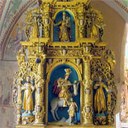0028 On the Hierarchy of Saints on Altars
Visitation Records of Otto Friedrich Buchheim, the Bishop of Ljubljana (1641–1664)
Identifiers (Article)
Identifiers (Files)
Abstract
The visitation records of Otto Friedrich Buchheim, the Bishop of Ljubljana from 1641–1664, offer an insight into the rules governing the disposition of saintly figures in altar retables. The central place was accorded to the titular saint, while companion saints are positioned in pairs (separately for each level of the retable) in such a way that those of higher rank are placed on the more distinguished gospel side, whereas those of lower rank stand on the subordinate epistle side. The priority of one saint over another was not a matter of a random choice, but of a fixed hierarchical order which was created over the course of centuries in the Litany of All Saints and also in the hymns of the officium for All Saints Day; this hierarchy, as Buchheim remarks, is "in agreement with the general feeling of the Catholic Church". Ecclesiastical art in Slovenia shows that in the Gothic period the hierarchical principle governing the disposition of saintly figures was not yet firmly fixed, but it was fully established in the late Renaissance and Baroque periods, which coincides with the period of unification of the Litany of All Saints for the entire Catholic Church. Later it started to loosen again, yet it remained in force up to the 20th century.
Statistics


License

This work is licensed under a Creative Commons Attribution-NonCommercial-NoDerivatives 4.0 International License.



